#reaches northwest 10th
Note
24 and 29 for fic writers asks.
24. Share a moodboard for (one of) your current WIP(s).
Going with:
24 Hours – basically, there’s this person that in 2000 decides to challenge L and gives him 24 hours to find them. Each hour they broadcast a new crime. Funny thing, which is immediately known so it’s not a spoiler, is that they are in the same building as L, pretending to be a plumber and they plan to blow up the building with both of them inside. They are so unhinged, and I love them so much. They literally plant a bomb under the kitchen sink in L’s apt, when he’s present, cuz they have a plan B: shoot him right there. Straight to the point. They don't care about the challenge itself, but to ruin L the detective and him not doing anything gives him a bad rep.






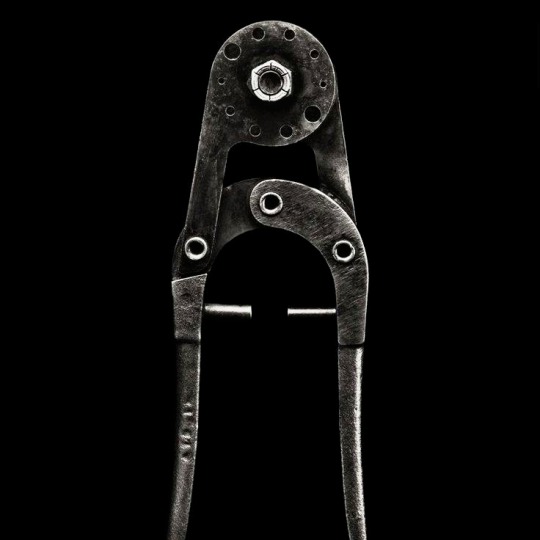


29. Share a bit from a fic you’ll never post OR from a scene that was cut from an already posted fic. (If you don’t have either, just share a random fic idea you have that you don’t plan on getting to.)
Okay, this death note fic idea is a weird one. I started writing it in my italian literature class, because I was bored. I wrote just the beginning bcause the class bell rang and I forgot about it. I don't intend to continue it lmao
Basically it's a case in which are involved poems by Giovanni Pascoli, that I was studying at that time. Nothing too elaborate and I didn't get all the details down, so yeah. Under the cut, the first part of the first chapter. L was supposed to appear after this scene, pretending to just take a walk in the graveyard, as someone does (he noticed the FBI cars from his apt and wanted to know more about what was going on, and Watari wasn't around).
The relentless clicking of the heels of the young Federal Bureau of Investigation agent Jessica Parker caught the attention of most of the forensic workers. They followed her parade down the central driveway with judging eyes. They knew why she was there, since they had witnessed the heated conversation that had taken place shortly before between her and team leader Flavius Bennett on the phone, but her short white strapless dress, decorated with pinkish lace and little flowers, and her pink handbag were, apart from being unusual, not appropriate for a place like that. And they did not refer to the cemetery they had found themselves in, but to the work she had to do.
"Finally!" Bennett exclaimed as soon as he laid eyes on her.
He passed the officer he was talking to and walked over to her.
"You could have worn something else..." He commented, eyeing her from head to toe.
"You could have not called me on my day off."
He handed her his clipboard and took off the jacket he was wearing, arranging it, then, over the girl's shoulders. He took the item back and signaled for her to follow him.
"I wouldn't have called you if it hadn't been directly addressed to you." He replied. "I'll briefly explain what happened, then, there will be Marlinson to tell you about details."
Jessica rolled her eyes and bit her lower lip, lest her disappointment at having to work with him be felt, but Flavius could sense it, nonetheless.
[...]
They reached the crime scene but remained quite far away so as not to get in the way of the forensic team's work. Jessica was able to observe the three corpses, anyway, lying side by side and carefully arranged. There was no visible blood or signs of any injuries at first glance, but she decided not to be immediately swayed by the sight, not knowing any further information about the deaths.
"We think it was a murder. The victim is Johanne Nelson, female, 24 years old, white, American, has no children and no boyfriend. Lives downtown on Northwest 10th Street. She attends Georgetown University, a thirteen-minute drive from her home. The car in her name is a two thousand nine BMW fifth series." He glanced quickly down the page and looked at the next one. "That's it. Any questions?"
He turned towards the woman, who was busy observing the crowd of people and her surroundings.
"And the two bodies at her side?" She asked, pointing at the corpses. "They look like they've been dead for quite some time."
"Because they are. They are the victim's mother and father. They were pulled out of their graves and laid out like that." He took a pause as he searched through his papers for a photo. "On the gravestone, it says this." He handed it to her.
The red writing, probably done with a felt-tip pen, because there were no smudges or lighter strokes, as would have happened if blood had been used, read:
“Io vedo, vedo, vedo un camposanto,
oscura cosa nella notte oscura:
odo quel pianto della tomba, pianto
d’occhi lasciati dalla morte attenti,
pianto di cuori cui la sepoltura
lasciò, ma solo di dolor, viventi.”
"Is that a verse from a poem...?" Jessica asked, shaking her head, confused.
"Not just any poem. It is by the Italian poet Giovanni Pascoli, who lived from the late nineteenth to the early twentieth century. It is the first poem in the collection Myricae." Flavius explained, handing her an impromptu translation of the text.
"Day of the Dead...? I think I read it years ago."
"Exactly. It talks about Pascoli's family unity that seems to have created a new family in the cemetery, much more united than the one that existed when they were alive, and to be condemning, in some way, the survivors."
"Are you telling me that, perhaps, it is a relative who has done this?"
"Probably. However, we asked the head of the cemetery if there are any other relatives in the area, but he said no."
"And, even if they were to be outside Washington..."
"They would have no way of having gone far, because we believe the crime took place between four and six this morning. And now, it's..." He looked at his watch. "Half past one, which doesn't explain this evening attire of yours."
"It's not evening, it's formal." She corrected him. "And that's not important, I'm here about a murder, not the death of my private life because of you."
Flavius chuckled, but Jessica did not find it extremely hilarious. [...]
"You can always..." Flavius pointed her gaze at Marlinson's curly blonde head, intent on checking the various pieces of evidence in the bags being brought to him.
"Forget it."
"I meant to make yourself useful and not waste time. Go talk to him." He put a hand on her back. "We have a murder to solve, go." He pushed her, risking knocking her to the ground.
13 notes
·
View notes
Text

In the spring of 1944 Bill and his P-51C “Berlin Express” were near Paris when the scene that is immortalized in the artwork by Len Krenzler of Action Art that leads this article took place. Bill had followed this Bf 109 from the bombers he was escorting when most of the German fighters left. The two planes had been in a running dogfight. The German pilot flew over Paris hoping that the heavy German anti-aircraft artillery would solve his problem and eliminate Overstreet and the “Berlin Express,” though Bill managed to get some hits in at about 1500 feet. The German’s engine was hit, and Bill stayed on his tail braving the intense enemy flak. His desperation undoubtedly growing, the German pilot aimed his plane at the Eiffel Tower and in a surprising maneuver, flew beneath it. Undeterred, Bill followed right behind him, scoring several more hits in the process. The German plane crashed and Bill escaped the heavy flak around Paris by flying low and full throttle over the river until he had cleared the city’s heavy anti-aircraft batteries.
On D-Day, June 6, 1944, Overstreet and his group took off at around 2AM in terrible weather, climbing to about 20,000 feet to get out of the overcast. He recalls it as beautiful when they had finally cleared the clouds, with a bright moon and the sight of all of the aircraft rising from the clouds after their long climb to get above the weather. With all the planes in the air, his wing never did find their assigned flights, so they just formed up in flights of four, knowing that their mission was to get to France and make sure no German fighter planes could interfere with the invasion as well as preventing German reinforcements from being brought up. Their first mission was six hours, then they had to return to base for fuel. His group flew eight missions on the day of the invasion.
June 7th brought a sortie that saw Bill and his mates strafing trains, trucks and military vehicles. On the 10th, more hits on German supply lines were carried out, with attacks on trains, trucks and barges. On the 29th the group’s success continued with Bill knocking out an Fw 190 and with Allied air superiority well established, Bill only used 40 rounds that entire day. General Kepner issued another commendation for the 357th and the 361st Groups, who destroyed 48 enemy aircraft without losing a single bomber.
On August 6, 1944, Overstreet flew his first long distance shuttle mission along with the 357th Fighter Group, which was selected to escort B-17s from the 8th Air Force’s 3rd Bomb Division on a shuttle mission to the Soviet Union. The group rendezvoused with the bombers seventy-five miles northwest of Gydnia, Poland. The group engaged several Me 109s near Gydnia, shooting down two of the German fighters. They regrouped after driving off the rest of the Me 109s and continued to escort the bombers until reaching Kiev. Seven and a half hours after taking off from Leiston, all of the 357th’s P-51s landed at Piryatin.
USAAF B-17 Flying Fortresses and Soviet Air Force Yakovlev Yak-9 fighters share an airfield as aircrews swap stories in 1944.
The group then escorted B-17s to Cracow, Poland, on the 7th and to Foggia, Italy, on the 8th. One thing that wasn’t in short supply in Russia was beet vodka, and not expecting resistance from the Luftwaffe on the group’s one-way mission to Foggia, Overstreet volunteered to trade the .50 caliber ammunition in his Mustang for bottles of vodka and loaded them into his now-empty ammunition bays. During the flight from Russia to Italy, the eminently predictable happened, and Bill’s group ran into some Me 109s on the way. The Mustangs gave chase, scaring one of the 109’s Pilots enough for him to bail out of his plane, and while Bill’s plane was the closest and therefore he could have claimed the kill, but wasn’t comfortable with the idea of bringing down an enemy fighter armed only with vodka. They managed to make it to Italy with both the formation and the vodka intact.
5 notes
·
View notes
Text
Hosted by Buoy Beer Company, LAGER FEST returns May 12th and 13th in Astoria, Oregon.

image courtesy Buoy Beer Company
Press Release
LAGER FEST is back at Buoy Beer Co.! Join us on the riverfront Friday and Saturday, May 12th and 13th as we celebrate the wonderful world of lagers with live music, great company, and unbeatable river views.
This year Buoy has partnered with more than a dozen West Coast breweries including Astoria Brewing, Block 15 Brewing, Fort George Brewery, Figueroa Mountain Brew Co., North Jetty Brewing, Sunriver Brewing, Obelisk Beer Co., pFriem Family Brewers, Reach Break Brewing, Steeplejack Brewing, Sisu Brewing, Mirage Beer Co., and more.
The festivities will begin Friday, May 12th at our original riverwalk location and will feature live music by Holiday Friends from 3-8pm. Lager Fest event mugs and tokens will be for sale on-site, giving lager lovers and beer lovers a chance to taste variations of the style’s color, fermentation processes, hop profiles, and malt flavors.
On Saturday, May 13th, we encourage you to start your day with Astoria’s 10th annual Run on the River Half Marathon, 10k, and 5k. Sponsored by Buoy Beer, Run on the River is a fundraiser for Astoria Parks Recreation and Community Foundation which helps individuals and families access health and wellness opportunities through scholarships. Sign up today to participate or volunteer. Volunteers will receive a Lager Fest mug for dedicating their time to this awesome cause!
The fest continues on Saturday 11am-8pm. Join us for a springtime day full of delicious lagers from our partner breweries, specialty lagers from Buoy, and live music all day from The Hackles and more.
During the festival you can also sign up for our Buoy Beer Club. The annual membership features perks like discounts on draft and packaged beer, discounts on merchandise (both at the brewery and online), invites to brewer social events, and more! Sign up during Lager Fest and your festival mug will be included in the membership price.
Come on down to Buoy May 12th and 13th and drink some tasty lagers with us. Pre-order your tokens to get your mug FREE here.
We look forward to seeing you. RSVP to the Facebook Event for updates!
from Northwest Beer Guide - News - The Northwest Beer Guide https://bit.ly/3kFFJTG
1 note
·
View note
Text
Suzhou in China
Suzhou in China
Suzhou, alternately romanized as Soochow, is a major city located in southeastern Jiangsu Province of East China. It is about 100 kilometers northwest of Shanghai, making it a significant economic center and focal point of trade and commerce.To get more news about suzhou china, you can visit shine news official website.
Founded in 514 BC, Suzhou has a long and productive history1. Around AD 100, during the Eastern Han dynasty, it became one of the ten largest cities in the world, mostly due to emigration from northern China1. Since the 10th century, Suzhou has been an important center of China’s industry and foreign trade.
Suzhou is also famous for its classical gardens, dating back to the 6th century BC, when the city was founded as the capital of the state of Wu. These gardens began emerging around the 4th century and reached their climax in the 18th century.
Today, Suzhou is a major economic center and a focal point of trade and commerce. It is the second-largest city in Jiangsu province, after its capital Nanjing. With high life expectancy and per capita incomes, Suzhou’s Human Development Index ratings are roughly comparable to a moderately developed country.
The city’s canals, stone bridges, pagodas, and meticulously designed gardens have contributed to its status as one of the top tourist attractions in China. Tourists can enjoy various activities such as sightseeing tours, full-day tours, cultural tours, historical tours, hiking tours, shopping malls, private day trips, rail tours, flea & street markets, water tours, shows, concerts & sports, specialty museums.
In conclusion, Suzhou is not just a city with a rich history and beautiful landscapes but also a thriving economic center. Whether you’re a history buff or an avid traveler looking for your next adventure, Suzhou has something to offer everyone.
0 notes
Text
Sintra, Portugal
September 5, 2023
We left Lisboa for a little while today to explore Sintra, Portugal in the Sintra Mountains.

Less than a hour away is this quaint village the at one time housed numerous castles and palaces of kings and other "upper crust" - so to speak. Our destination was Sintra National Palace, a 15th-century medieval palace where the Portuguese royal family spent their summers until the 1800s. It was good to be king!!
The weather was fall-like with temps topping out at 70 degrees today and 5% change of rain. (LIARS!!!). We left the city and it was sunny and bright but with every mile we saw less sun and more fog. Fortunately we saw these aqueducts before the fog swallowed us up.

This is NOT Roman designed or built - but most certainly Roman "inspired." Here is the buzz from the web about this structure.
"Built between 1731 and 1799, by royal order, the Águas Livres Aqueduct constituted a vast system for capturing and transporting water, using gravity. Classified as a National Monument since 1910, it is considered a notable work of hydraulic engineering.
The completion of this work involved using the Águas Livres water springs integrated into the Sintra mountain watershed, in the Belas area, northwest of Lisbon.
The chosen route coincided, in general terms, with the route of the ancient Roman aqueduct. Its construction was only possible thanks to a tax called Real de Água, levied on essential goods such as olive oil, wine and meat.
The system, which withstood the 1755 earthquake, is made up of:
A main section, 14 km long, starting at Mãe de Água Velha, in Belas, and ending at the Mãe de Água das Amoreiras reservoir, in Lisbon
Several secondary sections designed to transport water from around 60 springs
Five galleries to supply around 30 fountains in the capital
In total, the Águas Livres Aqueduct system, inside and outside Lisbon, reached around 58 km in length in the mid-19th century, with its waters no longer being used for human consumption from the 1968s onwards.
The extraordinary arcade of the Alcântara valley, with a length of 941 m, is made up of 35 arches, including, among these, the largest stone arch in the world, measuring 65.29 m high and 28.86 m wide ."
It was fun to see. Potable water was a big problem for Lisboa with springs located in the Alfama area - and that is it. The Tagus River - the longest river in the Iberian peninsula - is brackish in the city - so great for floating a ships - but not so good for drinking. I'm afraid I went down the rabbit hole on this and I REALLY wish we had visited the Water Museum and the Reservoir. The entire system is fascinating and made me think of the Cistern in Istanbul. Below is a pic I took off the net of the Mãe D´Água Reservoir. But I going to let it go....

Back to what we did instead of what we didn't....
We toured the palace for about an hour and saw the medieval, gothic, and Moorish architectural influences as we meandered through the palace’s decorative staterooms. I took lots of pics - but I took could give you the size of the place - so I tapped the Internet (again). The big conical structures are chimneys in the kitchen. Once we toured the kitchen, I understood why they were so big!

The first building was constructed in the 10th or 11th century when Sintra was under Moorish rule. At the end of the Middle Ages, the Palace of Sintra was at the heart of a large territory under the care of the Queens of Portugal while also one of the preferred destinations for Portuguese monarchs. The rooms were unique and the walls and ceilings were fabulous.

Welcome to the Swan Room.
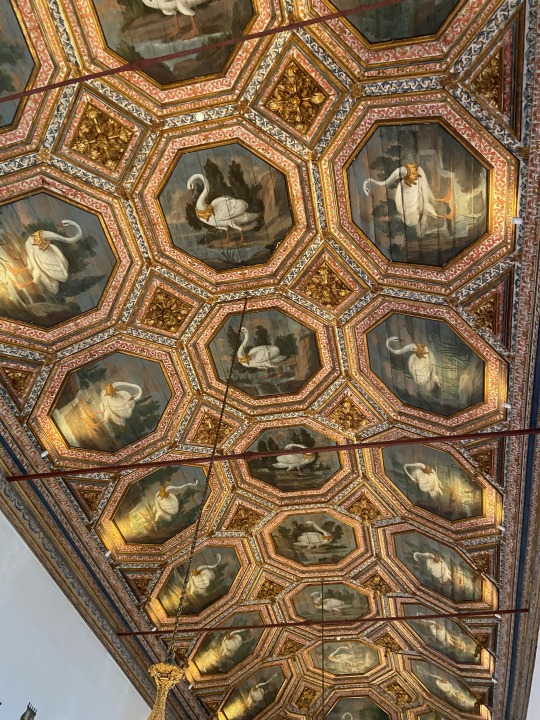
If you were lucky enough to get an audience with the king - you would wait in this room.


This outer room - that looks VERY Moorish - is the room outside the throne room. Then come in for your audience - into the "Magpie Room" - where rumors go to die.
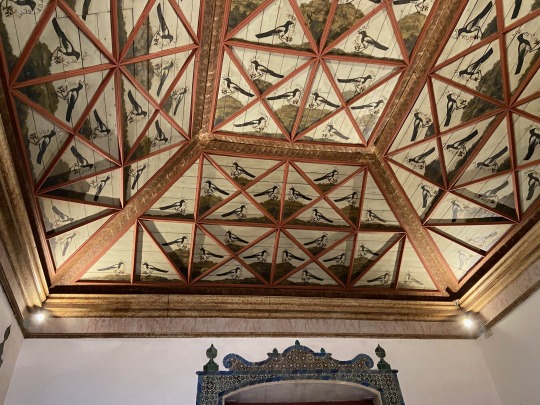

Every time the royal moved from one palace to another every stick of furniture went with them. OMG!!

These cabinets are amazing work of art. They close and lock and have handles - so that someone else can pick up that sucker and carry it to the next giant palace.

This room is for "exhibitions". For example, the queen has given birth to the new prince - come on in and take a look at the beautiful people. OR The King is Dead - check it out.
The different tiles on the walls are amazing.




I loved this garden - and it gives you a look at our weather. We "heard" you could see the ocean - and another palace in the near distance. Sure you could....
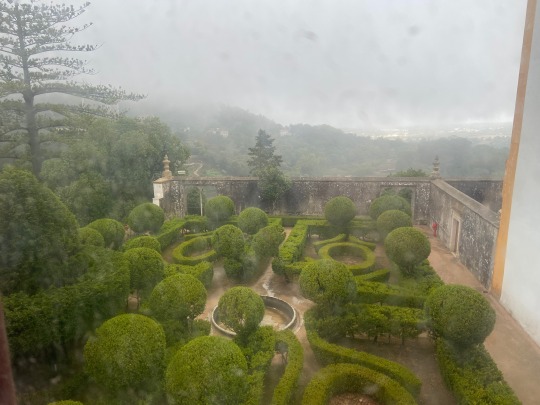
Below is the throne room - filled with the heraldry of the most powerful families.

In the middle is the crest of Portugal and the king. It was surrounded by the crest of his 8 children - 6 boys and 2 girls. Can you find the girl's crests? Look for 1/2 a crest!!!! Don't get me going.....
Sometimes, a loyal subject with great power does something bad or someone tells the king they did something bad - and just like that...

See the blank section above? This very influential family MAY or MAY NOT have been plotting to overthrow the king - but we will never know - because the King listened to Marquis de Pombal who said they were - and suggested that the entire family - EVERY SINGLE MEMBER - be killed to prevent such an event. They - grandparents, children, cousins, aunts, uncles, etc. were killed and their crest disappeared FOREVER!!f
We continued to the chapel and discovered it was under renovation.


WOW!!!
The kitchen was near the end of the tour - and very interesting indeed:

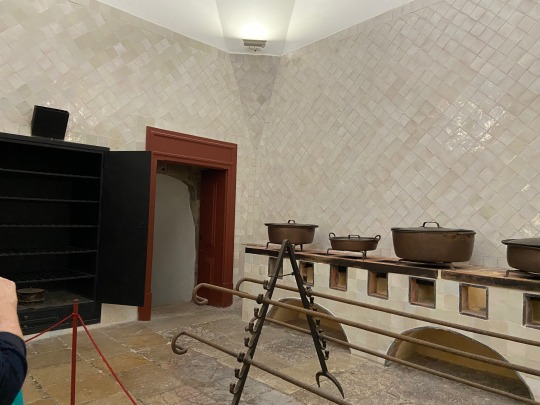

This mammoth kitchen had everything! From a huge doors that opened to bring in the kill, to places where the meat was hung, bled and butchered. The fires to cook whatever needed to be cook were built under the mechanism. So - if the goal was to cook several pigs or deer or, or or - on the spit by Carolina, a fire was built on the floor. And THAT explains why those giant chimneys were a must.
Finally, how about a loverly chandlier for over the dining room table. This one came from a small glass manufacturer called Murano, in Venice.

We had a few minutes to shop after the tour and then a great lunch - while the rains poured on.
I thought the trip was very worthwhile and I think all our our friends felt the same way. Our timing was good too. The 5% chance of rain "poured" beginning moments after we went into the palace. It was raining when we finished our tour as well but we were not deterred.
We headed back to Lisboa and Carolina suggested we might use the time to "meditate" (wink-wink) and we all did exactly that. DEEP MEDIATION!
We stopped by the Tower Belém - a place Mark and I have been to two times this trip but it was still fun to see again with our buddies. From here we went to see The Discoveries Monument. We have NOT seen this up close and personal so that was indeed fun. We especially loved the marble map that had been a gift from South Africa. There were just too many people to get a descent pic - so I'm going to the Internet. There are people in this pic too - but they will give you the prespective to understand just how big this thing is.

It lists the date and location of each of the numerous colonies that were part of Portugal's Empire. Here is a pic I took of just s small section.
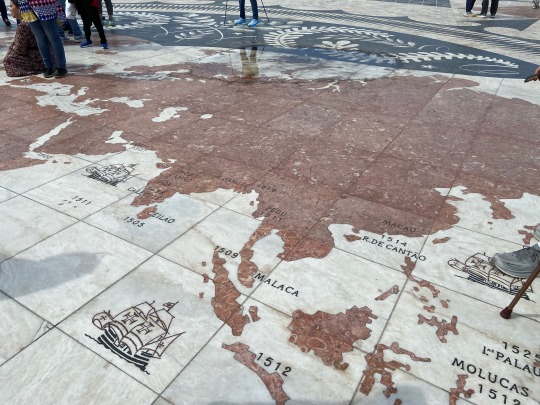
I remain conflicted about the "discovery" notion. None of these places were unpeopled. The lands had long ago been "discovered" - but now they were conquered. It is what it is - and NO ONE is denying that these conquests make Portugal rich beyond their wildest dreams. They spread their language, their culture and their religion around the world - but there was a horrific cost to the conquered, my friends. So, I remain conflicted.
Lastly, we had our home hosted dinner. Our host was an AMAZING artist, a woman who was indeed a free spirit. We had such a spirited conversation that I'm ashamed to say we took no photos. But we will have to keep this night in our hearts. Mark, Daphne, Joe, Annie, Carl and I had a delightful evening - so much so that we were late for our return back to the hotel. Oh well.
Tomorrow we leave Lisboa and head to Evora. The name of the trip is "The Back Roads of the iberian Peninsula: Paradores and Pousadas. So far, we have seen NO back roads. But according to our trip leader the "back roads" start tomorrow. Can't wait!
Stay tuned.
0 notes
Link
0 notes
Text
What Erling Haaland told Dominik Szoboszlai after he completed £60m Liverpool transfer

What Erling Haaland told Dominik Szoboszlai after he completed £60m Liverpool transfer
Dominik Szoboszlai has disclosed that he contacted Erling Haaland, the striker for Manchester City, seeking advice after finalizing his transfer to Liverpool on Sunday.
The £60 million acquisition has also provided information about his packed schedule off the field prior to commencing pre-season training with Liverpool on July 11 at the AXA Training Centre.
The signing of Szoboszlai marks Liverpool's second acquisition this summer, as he signed a five-year contract after successfully completing a medical examination at the Reds' Kirkby facility.
Liverpool acted swiftly to finalize the agreement with RB Leipzig after engaging in discussions with the player's representatives early last week. The Reds activated the £60 million release clause of the 22-year-old on Friday and promptly arranged for his arrival in Merseyside on Saturday afternoon.
Szoboszlai and Haaland formed a strong bond during their shared tenure at Red Bull Salzburg, and the new Liverpool player, who now wears the No. 8 jersey, believes that there is a chance they could end up living close to each other in the northwest region. This possibility arose from a conversation Szoboszlai had with his fellow forward from Norway.
"We've talked," Szoboszlai told the Hungarian-based Nemzeti Sport. "So much so that Erling Haaland has also advised on finding real estate, and it could very well be that we become neighbours.
"I learned from him that several players live halfway between Manchester and Liverpool in a quiet area where privacy can be preserved, and on Monday I will see what he was talking about, I am very curious.
"And of course, putting our friendship aside during the Liverpool-Manchester City matches, it will surely be a fantastic experience to play against each other."
Szoboszlai also sought the counsel of former Liverpool goalkeeper Peter Gulacsi who he played with at Leipzig, adding: "I've spoken to him before and he knows what our relationship is like. He was there in Leipzig when I got there, I became a player for the club and I could count on his support from the very first moment.
"He was a very good team-mate of mine and I hope he got over his injury and there will be another Champions League match between Liverpool and RB Leipzig where he can try to save my free-kick!
"I'll do some training on Monday, I have some paperwork to do, and then look at some potential properties where I'd like to live. Then I have to go to Leipzig, pack up my stuff, say goodbye to my former club, thank everyone for their support, love and encouragement and then to Budapest. But on the 10th at the latest I will be back in Liverpool, because on the 11th I will be training for my new team."
With the signing of Szoboszlai, Liverpool's expenditure for this transfer window has now reached £95 million. This figure includes the previous addition of Alexis Mac Allister from Brighton & Hove Albion in early June. The Hungarian midfielder acknowledges that he does not want to burden himself with excessive pressure at this stage as he gets ready to embark on his journey with his new club.
"I don't want to look too far," he said. "I'm trying to take it step by step, I definitely need time to get used to the rhythm of the Premier League, the way Liverpool plays, Jurgen Klopp's ideas.
"The opportunity to play is the most important thing, as always, and if I have that, obviously I want to score as many goals as possible, give assists, make myself accepted by my surroundings, by the fans. I want to deserve the confidence that they give me here in Liverpool at every moment."
What Erling Haaland told Dominik Szoboszlai after he completed £60m Liverpool transfer
Read the full article
0 notes
Text
Daarunbay Detevay 2
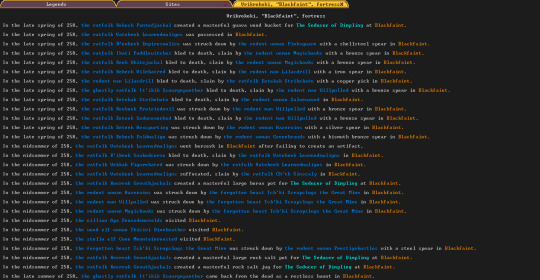
When you zoom out and look at it like this, it's not really an anomaly. Like, it's fucked up, but it's barely even a footnote.
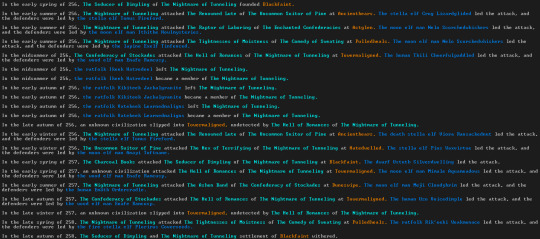
In the grand history of The Nightmare of Tunneling, which is thousands and thousands of lines long, Blackfaint is two of them. It started and then it ended. The Land of Nails is a cruel place where life moves fast from beginning to end. The Hill of Scars just happens to be one exceedingly fast-paced part of it. I haven't really provided many good visual aids, so here's an image of the Daarunbay Detevay in its entirety which took me way too long to make.
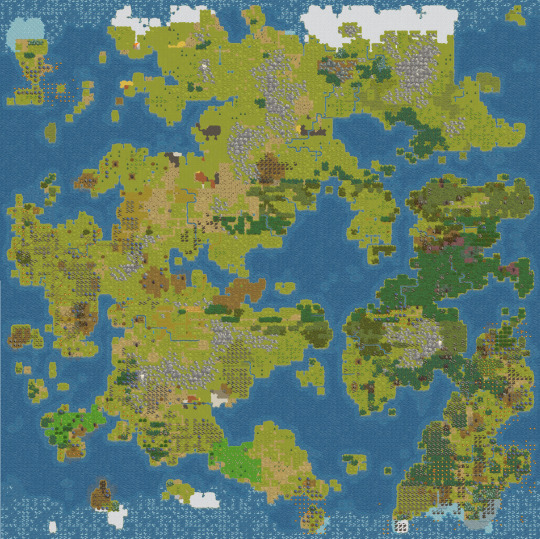
The whole world! The Land of Nails is the western continent, the Land of Dividing is the eastern one. Where's The Hill of Scars in all of this, you might ask?

"Circled" in red is The Hill of Scars. Over on the left in blue, Rushsly. And on the right in puke green, Blackfaint. All the history of The Nightmare of Tunneling, of The Comedy of Sweating, has been constrained to this little western chunk of the continent. We have barely scratched the surface of the surface, even with our deepest dives into the history of kobbles and ratfolk. There's like 10 other major civilized species inhabiting the world, some of them not even on this continent that we've only known a little 1/10th swatch of. For instance, did you know there's fucking crab people?

There's crab people, baby. Well, that's an oversimplification. They're Decapoda, which is an umbrella term that includes lobsters, shrimp, and all kinds of crabs. The Axe of Glaciers live on the edges of the world, where it's cold: all the way up northwest on the glacial Island of Fate, and another decapodian civilization named The Paddle of Furs lives far to the southeast, among The Hills of Dividing and the terrifying Glacier of Corrupting at the end of The Land of Dividing - some even living out on the great ice floes in the arctic ocean. The harsh conditions come natural to such hardy peoples - after all, even the humble shrimp among them can heal well enough to regrow lost limbs.

There may very well be lobsters among us older than the very concept of counting years. And hell, there's one among The Axe of Glaciers who's as old as the calendar. The first King of Decapodia: Kuteci Peaceletters.

There's something very interesting about his reign, besides the "suddenly getting deposed in a coup" part. Yes, obviously, it's the "throwing competition" part. Obviously, losing 10 years in a row is one thing - but in the very first one at Bronzeskies, the seat of AoG, he actually won that one. The fact that he put the competition to rest until right at the end of his reign is just... interesting. Did he keep trying it again thinking he'd recapture the glory of his youth? Been there. Did his desperate attempts turn everyone against him? Been there. I don't throw controllers or anything because them shits cost like $60 for a good one but I haven't been able to enjoy fighting games for over 3 years because lately when I lose I get so fucking mad I punch my desk. Part of my ego is inextricably linked with the idea that "I have to be good at games." If I hop on an FPS and get headshotted over and over I have to just turn that shit off. I physically cannot handle "getting dominated" because I have so few avenues for success in my life that I have latched on to "yeah, I'm good at Sniper in Team Fortress 2" as one of my last pathetic desperate reaches for validation. I don't know what's wrong with me. I try to not be like this. I'm reading The Inner Game of Tennis but it hasn't really helped me yet. I can't play Street Fighter 6 off my friend's Steam family-share library because if I get put in the corner and don't tech the throw twice in a row I just have to turn the fucking game off, I alt-f4 out of it immediately, I can't stomach failure and victory only even feels like a reprieve from loss. I realize this is so much more pathetic than just being bad at games. In fact a guy who's bad at games and a good sport about it is probably the best thing you can be, because whenever anyone says "wow you're bad at this" you can just be like "Yeah I was too busy going outside and having sex and stuff." But I haven't been!! I've been here, sitting at my fucking desk, playing video games!! I should at least get Fortnite wins and not just in those first few games after you haven't played in a while where the whole lobby is bots, I mean I should be able to out-snipe any zoomer in the world with my 20 years of Counter-Strike experience or at least I fucking tell myself that, even though I've never fucking practiced the game or its particular flavor of sniping, or when I have it's just for like 5 flaccid minutes of not challenging myself because my ego is too fragile to actually let me!! I mean I'll tell you up and down the fucking block that battle royales are a literal cancer that caused "good map design" to be amputated from the modern multiplayer first-person-shooter genre and that actually is true but you'd never know it because I'm such a fucking bitch who fucking cries over never winning in Apex Legends even though I like Titanfall 2 way better but I can't fucking play that either because I get too fucking mad and competitive and hard on myself to enjoy it unless I'm playing absolutely perfectly!! Like what the fuck!?!? I'm 30 years old!! If I went back to my 10-year-old self and said "this is what you grow up to be, little guy" he would start downing shots of bleach right there on the spot!!! But I don't know how to change!!! My ego, my wavering sense of self completely dominates me and prevents me from enjoying my life and my so-called passions!! And it really feels like there's no way to fix it short of just tripping on so much acid I completely forget my current personality!! Even then what if it just comes back!!

The one who deposed Kuteci and reigns to this day is the former baroness, Scucutk Raspboats, whose true goal is to create a great work of art. Throughout her life, she has written eleven pieces of literature, but she only bothered to name six of them: Errors In the Keep, her first. The Journey Into Scucutk Raspboats, her third. The Truth About the Decapod fourth, The Wizard'S Guide to Creation sixth, Discourse on Pagesnarling (named for her barony) eighth, and After Genius tenth. Her last book, untitled, was writen in 163, and just 5 years later she would seize the throne in Bronzeskies and thus the throne of all decapodia, aided by Rerrr Crazyletter, the baroness of Gorgelearned, and Rerrr's daughter Cecichi Springchannels, duchess of Diamondtangled.

Legends Browser 2 seems to not like how many mods I've got running, but it doesn't look like we're missing too much. Besides their positions of significance in The Axe of Glaciers, they are mostly unremarkable women - all unlucky in love, but who isn't?
Why does any of this matter? Because it's clear Scucutk cannot write her true masterpiece from where she sits. Caravans are sent out all the time in search of a better location for a true grand library, one where she might finally create the artifact that has eluded her for all her life. Because I've never actually played a cold-weather biome, and it sounds both fun and more manageable than whatever the fuck Blackfaint ended up being. Because playing as lobsters and crabs sounds really funny

So at the northwestern tip of the world, we'll try it again. Unlike in other video games, it's very fun to lose in the greatest simulation game of all time Dwarf Fortress, I've talked at length about that already. So why don't we try to make the greatest library Of All Time in possible the least hospitable environment Of All Time?

What could possibly go wrong?????
1 note
·
View note
Text
What is the Origin of Arabic: Know from SayDhad

Languages traveled on the SayDhad alongside cultural elements, traditions, and religious views. Arabic is one of the languages that spread into the western regions, as Arab merchants and scholars traveling along with SayDhad helped promote the spread of the Arabic language to different areas.
Arabic, which originated in the Arabian Peninsula's northwest, is a member of the Semitic language family, which also contains Hebrew and Aramaic. Although the earliest manifestations of Arabic stretch back to the 8th century BCE, the language has been defined and refined over a long period of time. A major portion of this development happened between the third and sixth centuries AD, with other additions to the script made in the seventh century AD, when ancillary signs were added to letters to avoid ambiguity over how to read text. The 10th century saw a surge in interest among Arabic linguists, with at least six Arabic dictionaries published alongside more specialist works.
The nomads and merchants of the central and northern Arabian Peninsula spoke various dialects. It is widely assumed that the origins of contemporary dialects can be found in these ancient languages of the Arabian Peninsula's central and northern regions. The movement of these groups aided in the spread of various Arabic vernaculars to the south of the Peninsula, as well as to Mesopotamia. As a result, Arabic, like Islam, expanded to the far reaches of the globe. The herders carried their language with them west to Northern Africa and north to the Taurus Mountains. The mingling of different tribes and the various local languages of these diverse regions favored the gradual emergence of local dialect forms in Northern Africa.
The Arabic language also played an essential role in the different exchanges in every nation, particularly in Gulf countries. As a result, because Arabic was at the heart of scientific and cultural exchanges, these various interactions and cooperation in varied domains added to its diffusion and, thus, enhancement of SayDhad.
Now anyone can learn Arabic quickly with us with the great Arabic scholars of our platform.
0 notes
Text
Annapurna Base Camp Trek Guidebook
Traveling in Nepal is an unforgettable experience for travel enthusiasts. Don't get lost in the middle of snow covered mountains and enjoy them every time, yes Annapurna Base Camp Trek (in short you can say ABC Trek) is undoubtedly one of the trekking routes the most spectacular in the foothills of the Annapurna Himalayas. Northwest Nepal offers breathtaking views of the world's 10th highest Mount Annapurna, as well as many surrounding mountain ranges.

Annapurna is the highest peak of the six highest peaks, Annapurna I (8,091 m), Annapurna II (7,937 m), Annapurna III (7,555 m), Annapurna IV (7,525 m), Gangapurna (7,455 m) and Annapurna South. . (7,219 m). Along this side, the sacred and most famous peak of Machapuchhre in the southern region of Annapurna is also seen. All Annapurna Base Camp treks take you through beautiful valleys, thick forests of rhododendrons, junipers, deep rivers, beautiful mountains and the diverse culture and traditions of the Gurung community. The name Annapurna mountain comes from a Hindu legend called "My Annapurna" which means full of grain or provider of food.
Highlights of Annapurna Base Camp Trek?
• Historical village of Ghandruk, Gurung village, their customs, traditions and customs.
• A pleasant and warm trek from the shores of Modi Khola, passing through the alpine forest inside the Annapurna Reserve.
• Magnificent sunset view from Poonhill lookout over the snow capped peaks of Dhaulagiri Mountain, Annapurna Ranges, Nilgiri and many more.
• Discover amazing flora and fauna in the famous Annapurna Conservation Area. • The amazing way comes from a large number of beautiful cities, waters, the forests live in Alpine.
• Walking among the tenth tent of Marta.
• Closest view of the 10 highest mountains in the world Annapurna I, and (Annapurna II, Annapurna III, Annapurna IV, Annapurna V, Annapurna South, Gangapurna.
• Different faces of Annapurna mountain range - Mt. Machhapuchhre.
• Views of the great Annapurna South, Annapurna Glacier and Annapurna Base Camp, with a 360 degree mountain view.
• Natural hot spring at Jhinu Danda.
How long does it take to walk to Annapurna Base Camp?
Usually the trek to Annapurna Base Camp is 67 km long and takes 10 days from Pokhara to return to Pokhara. However, sometimes it may take a few extra days due to unpredictable weather conditions and additional bookings. This trek is a moderate trek down the Annapurna Himalayas, so you need to exercise your body to prepare for the Annapurna Base Camp trek. There are two different routes for the Annapurna Base Camp trek. One takes a jeep directly from Pokhara to Ghandruk and starts the trek from there. Another is to take a jeep to Thikhedhunga and drive through Poonhill.
Is the Annapurna Base Camp Trek tough?
Annapurna Base Camp trek is considered as a trekking route which covers about 70 km in 10 days. This journey is one of the most rewarding but also requires quite a bit of preparation to reach this level. Cardio exercises, running, regular jogging, and some stretching a few weeks before a ride are good ideas to improve your endurance. Normal fitness levels and beginner hikers can easily do this hike, but for beginners, it requires a good orientation of the mountain weather, wind and environment. However, if we have more experience and experience, the trip will be easier and more interesting. Previous trekking experience will be an added advantage for you as you don't need any other mountaineering skills and techniques to do the Annapurna Base Camp trek. Generally, hikers who can walk for 5-7 hours a day with small packs and small lights join this easy trip. The route includes rocky hills, steep climbs, descents, narrow paths, river banks, straight roads, and sometimes slippery snow roads. It is important that you are as fit as possible before starting your journey.
What is the best time for Annapurna Base Camp Trek?
The climate in the Himalayas is different from what we have heard, read and expected about. In the case of Nepal, usually in the high mountains, people like to travel in spring and autumn. During these two seasons, you can have the opportunity to enjoy good weather, good roads and beautiful views of snow covered mountains. Spring usually falls from March to May. This is the time of year when wildflowers bloom and you will experience the best temperatures in the mountains. Also, the mountains are open from morning to afternoon, so you can enjoy a beautiful view of the snow-covered mountains during spring. In Nepal, most of the trekking activities take place in the spring. On the other hand, autumn is the most preferred season for tourists, which falls from the end of September to the middle of November. This is the best time of the year for mild days and unobstructed mountain views. The weather also favors the trekkers as you witness some monsoon and mountain sports that will add to the beauty of the Himalayas. Of course, winter and heavy rains are possible in the mountains, but you need a good guide and preparation for all the unexpected in the mountains. We usually recommend spring and autumn for Annapurna trekking.
What is the temperature of Annapurna Base Camp?
The first few days of trekking in the lower Himalayas tend to be hot and moderate in the alpine forests and foothills. The second half of the trek takes you straight into the cooler and usually colder mountains of the mountains. At the Annapurna base camp, the temperature can be 2 to -10 degrees on average. Keep your clothes ready. The morning and evening will be cool and the day will be hot until the weather turns to wind. Compared to other popular treks like Everest Base Camp, Annapurna Circuit Trek and Manaslu Circuit Trek, Annapurna Base Camp trek is a bit cooler.
Permit of Annapurna Base Camp Trek?
As the Annapurna Base Camp trek is located within the Annapurna Conservation Area, you need to obtain the appropriate permit to enter the Annapurna area. If you are traveling through the local travel agency, they will arrange all the necessary permits and access to get inside the Annapurna Region. Trekkers can get an ACAP entry permit and TIMS card by submitting a copy of their passport and two passport size photographs.
Eligibility for SAARC countries:
• ACAP Entry Fee: Rs 200/-
• TIMS card fee: $20 for solo travelers and $10 for group travelers.
Licensing for other countries:
• ACAP Entry Fee: Rs 3,000 (USD 26)
• TIMS card fee: $20 for solo travelers and $10 for group travelers
The ACAP entry permit and TIMS card are valid for one entry into the region and you must carry two permits during the trip. These entry rights are non-transferable and non-refundable. You can get both permits from the Nepal Tourism Board office in Kathmandu and the TAAN office in Pokhara if you are traveling only in the Annapurna region.
Travel Insurance for Annapurna Base Camp Trek?
When you are traveling or traveling in high altitude, your travel insurance is very important. Travel insurance is one of the most important documents for trekking in the Himalayas anywhere in Nepal. Trekking in Annapurna base camp is a very high trek as you have to cross 4,000 m altitude, narrow roads and sometimes. So, if travelers are worried about anything that might happen while traveling, this insurance might be the best for you. This saves you from paying a lot of money at one time, so we request all travelers to purchase travel insurance before traveling to Nepal for any type of adventure travel. In addition to this, make sure that your insurance policy also covers emergency helicopter evacuation, medical expenses and that the policy covers at least 5000m altitude.
Is it possible to travel alone for Annapurna Base Camp Trek?
A solo trek or a woman-only trek to Annapurna Base Camp is possible but not recommended. During the peak travel season, you will meet many travelers from different countries along the way. However, we advise you to go in a group or to a local office in the higher mountains. The Annapurna region is almost always easy to navigate, but sometimes you will find many trails created by locals. As you go up, the village becomes smaller, many different paths will come and if anything happens, you can feel helpless. Traveling with a guide and in a group can be strenuous but it is the safest way in the high mountains. You can face the problem of surface diseases, common injuries and other things that sometimes come out of it. For such a situation, your guide will help you take the necessary precautions that will eventually help you reach your destination. Local guides also show you the right route, give you an idea of the daily trek, distance, time and location of the trek and the best things about the Annapurna region, the name of the mountain, the people of this country, their culture, and information. others are important about this approach. So, we only recommend trekking to Annapurna Base Camp if you are well aware of the outcome and the route of the future trek.
What to pack on Annapurna Base Camp Trek?
Since the Annapurna Base Camp Trek is a successful trek in the Annapurna region, make sure that you do not bring too much especially if you are planning to do it without a porter and it is even solo. You don't need a lot of things because you will be staying in the tea house every night. Normally for clothes you can bring a pair of base layers, a second layer and an outermost layer.
• Wearing pants and shorts.
• Lightweight polyester shirt.
• A waterproof jacket and raincoat will also come in handy. Sometimes there can be chance of unexpected rain even during normal travel.
• Mandatory underwear and at least 4 pairs of socks.
• Gloves, hat, neck warmer and frame cover. So that you can save your face from the strong wind.
• A pair of walking shoes, sunglasses, a pair of shoes, a travel bag and other medicines you usually take if you take them.
• Sleeping bags, toilet paper, toothpaste, teeth, toothbrushes and use of your hands.
• In addition, the most useful bottle is water bottles and white water if you want to drink a horizon.
0 notes
Text
Events 7.11
472 – After being besieged in Rome by his own generals, Western Roman Emperor Anthemius is captured in St. Peter's Basilica and put to death.
813 – Byzantine emperor Michael I, under threat by conspiracies, abdicates in favor of his general Leo the Armenian, and becomes a monk (under the name Athanasius).
911 – Signing of the Treaty of Saint-Clair-sur-Epte between Charles the Simple and Rollo of Normandy.
1174 – Baldwin IV, 13, becomes King of Jerusalem, with Raymond III, Count of Tripoli as regent and William of Tyre as chancellor.
1302 – Battle of the Golden Spurs (Guldensporenslag in Dutch): A coalition around the Flemish cities defeats the king of France's royal army.
1346 – Charles IV, Count of Luxembourg and King of Bohemia, is elected King of the Romans.
1405 – Ming admiral Zheng He sets sail to explore the world for the first time.
1410 – Ottoman Interregnum: Süleyman Çelebi defeats his brother Musa Çelebi outside the Ottoman capital, Edirne.
1476 – Giuliano della Rovere is appointed bishop of Coutances.
1576 – While exploring the North Atlantic Ocean in an attempt to find the Northwest Passage, Martin Frobisher sights Greenland, mistaking it for the hypothesized (but non-existent) island of "Frisland".
1616 – Samuel de Champlain returns to Quebec.
1735 – Mathematical calculations suggest that it is on this day that dwarf planet Pluto moved inside the orbit of Neptune for the last time before 1979.
1789 – Jacques Necker is dismissed as France's Finance Minister sparking the Storming of the Bastille.
1796 – The United States takes possession of Detroit from Great Britain under terms of the Jay Treaty.
1798 – The United States Marine Corps is re-established; they had been disbanded after the American Revolutionary War.
1801 – French astronomer Jean-Louis Pons makes his first comet discovery. In the next 27 years he discovers another 36 comets, more than any other person in history.
1804 – A duel occurs in which the Vice President of the United States Aaron Burr mortally wounds former Secretary of the Treasury Alexander Hamilton.
1833 – Noongar Australian aboriginal warrior Yagan, wanted for the murder of white colonists in Western Australia, is killed.
1848 – Waterloo railway station in London opens.
1864 – American Civil War: Battle of Fort Stevens; Confederate forces attempt to invade Washington, D.C.
1882 – The British Mediterranean Fleet begins the Bombardment of Alexandria in Egypt as part of the Anglo-Egyptian War.
1889 – Tijuana, Mexico, is founded.
1893 – The first cultured pearl is obtained by Kōkichi Mikimoto.
1893 – A revolution led by the liberal general and politician José Santos Zelaya takes over state power in Nicaragua.
1897 – Salomon August Andrée leaves Spitsbergen to attempt to reach the North Pole by balloon.
1899 – Fiat founded by Giovanni Agnelli in Turin, Italy.
1906 – Murder of Grace Brown by Chester Gillette in the United States, inspiration for Theodore Dreiser's An American Tragedy.
1914 – Babe Ruth makes his debut in Major League Baseball.
1914 – USS Nevada (BB-36) is launched.
1919 – The eight-hour day and free Sunday become law for workers in the Netherlands.
1920 – In the East Prussian plebiscite the local populace decides to remain with Weimar Germany.
1921 – A truce in the Irish War of Independence comes into effect.
1921 – The Red Army captures Mongolia from the White Army and establishes the Mongolian People's Republic.
1921 – Former president of the United States William Howard Taft is sworn in as 10th chief justice of the U.S. Supreme Court, becoming the only person ever to hold both offices.
1922 – The Hollywood Bowl opens.
1924 – Eric Liddell won the gold medal in 400m at the 1924 Paris Olympics, after refusing to run in the heats for 100m, his favoured distance, on a Sunday.
1934 – Engelbert Zaschka of Germany flies his large human-powered aircraft, the Zaschka Human-Power Aircraft, about 20 meters at Berlin Tempelhof Airport without assisted take-off.
1936 – The Triborough Bridge in New York City is opened to traffic.
1940 – World War II: Vichy France regime is formally established. Philippe Pétain becomes Chief of the French State.
1941 – The Northern Rhodesian Labour Party holds its first congress in Nkana.
1943 – Massacres of Poles in Volhynia and Eastern Galicia by the Ukrainian Insurgent Army within the Reichskommissariat Ukraine (Volhynia) peak.
1943 – World War II: Allied invasion of Sicily: German and Italian troops launch a counter-attack on Allied forces in Sicily.
1947 – The Exodus 1947 heads to Palestine from France.
1950 – Pakistan joins the International Monetary Fund and the International Bank.
1957 – Prince Karim Husseini Aga Khan IV inherits the office of Imamat as the 49th Imam of Shia Imami Ismai'li worldwide, after the death of Sir Sultan Mahommed Shah Aga Khan III.
1960 – France legislates for the independence of Dahomey (later Benin), Upper Volta (later Burkina Faso) and Niger.
1960 – Congo Crisis: The State of Katanga breaks away from the Democratic Republic of the Congo.
1960 – To Kill a Mockingbird by Harper Lee is first published, in the United States.
1962 – First transatlantic satellite television transmission.
1962 – Project Apollo: At a press conference, NASA announces lunar orbit rendezvous as the means to land astronauts on the Moon, and return them to Earth.
1971 – Copper mines in Chile are nationalized.
1972 – The first game of the World Chess Championship 1972 between challenger Bobby Fischer and defending champion Boris Spassky starts.
1973 – Varig Flight 820 crashes near Paris, France on approach to Orly Airport, killing 123 of the 134 on board. In response, the FAA bans smoking in airplane lavatories.
1977 – Martin Luther King Jr., assassinated in 1968, is awarded the Presidential Medal of Freedom.
1978 – Los Alfaques disaster: A truck carrying liquid gas crashes and explodes at a coastal campsite in Tarragona, Spain killing 216 tourists.
1979 – America's first space station, Skylab, is destroyed as it re-enters the Earth's atmosphere over the Indian Ocean.
1982 – The Italy National Football Team defeats West Germany at Santiago Bernabéu Stadium to capture the 1982 FIFA World Cup.
1983 – A TAME airline Boeing 737–200 crashes near Cuenca, Ecuador, killing all 119 passengers and crew on board.
1990 – Oka Crisis: First Nations land dispute in Quebec, Canada begins.
1991 – Nigeria Airways Flight 2120 crashes in Jeddah, Saudi Arabia killing all 261 passengers and crew on board.
1995 – Yugoslav Wars: Srebrenica massacre begins; lasts until 22 July.
2006 – Mumbai train bombings: Two hundred nine people are killed in a series of bomb attacks in Mumbai, India.
2010 – The Islamist militia group Al-Shabaab carried out multiple suicide bombings in Kampala, Uganda, killing 74 people and injuring 85 others.
2010 – Spain defeat the Netherlands to win the 2010 FIFA World Cup in Johannesburg.
2011 – Ninety-eight containers of explosives self-detonate killing 13 people in Zygi, Cyprus.
2015 – Joaquín "El Chapo" Guzmán escapes from the maximum security Altiplano prison in Mexico. It's his second escape.
2021 – Richard Branson becomes the first civilian to be launched into space via his Virgin Galactic spacecraft.
2021 – Italy defeats England in the UEFA Euro 2020 Final to win their second European title.
1 note
·
View note
Text
An omega blocking pattern is developing across much of Canada and will be good news for some, but bad news for most. Blocking patterns mean that the same type of weather is repeated for days or even weeks.
An upper low over Hudson Bay is what's responsible for the early June snowfall in northern Manitoba and will also drive the cooler air expected across most of Eastern Canada in the days to come.
A second upper low is sitting off the coast of Mexico and a ridge is stretching along the Rockies and into the Yukon, and this will feed off Pacific and coastal air.
If not, the city will likely break the record for the longest wait for the first 20-degree day. The current record is June 10th and it’s been over a month since then.
The real winners of this weather pattern are likely to be in the north of Canada, where temperatures could reach up to 25C. Whitehorse will be the warmest capital city in the country on Thursday, with a forecast high of 24°C, according to the CBM.
The foothills in the Northwest Territories will be provided with some downsloping warmth and will likely be the location for Canada's warmest temperature. The Mackenzie River Valley could also reach 30°C, only seven weeks after sitting at -20°C.
0 notes
Note
get me :)
If they’re not going to tell us anything about the finale, I guess I’m just gonna have to manifest my own damn self.
The thing is Buck isn’t actually on shift when it happens.
In fact, he specifically called out because he needed to get his head on straight after the disaster of an afternoon he spent at Eddie’s two days before—surprised into meeting Ana and uncomfortable enough at the fact that they kept getting in each other’s way with Christopher, at the way he felt like an intruder in a space he used to think of as practically his own, that he made up an excuse to leave early and avoided Eddie’s concerned texts for the rest of the day.
But the universe doesn’t care about what Buck thinks he needs because he’s out on a walk when he hears the sirens. He gets a text from Taylor a minute later.
Heading out to cover a 5 alarm apartment fire, heard the 118 was called to the scene—you working?
Buck really couldn’t say why he freezes in place, ice suddenly gripping his heart. They’ve dealt with calls without him before. Bad ones, even. There’s no reason to worry, no reason to assume that anything will go wrong. But he stares at the text until the screen dims, unable to shake the feeling like someone’s walked over his grave.
No, he types out finally. What’s the address?
It’s stupid—he’s in civilian clothes, has no protective gear, so it’s not like he expects to be able to do much when he gets to the scene anyway, but—
But. He should have been there in the first place. And if anything does happen, he’ll never forgive himself for not being there to help.
“Cap!” Buck yells when he catches sight of Bobby after slipping the perimeter. “What’s going on?”
Bobby’s face is drawn and tired, his skin streaked with ash and sweat, and Buck assumes he doesn’t bother asking what Buck thinks he’s doing because he has enough else to deal with.
“We got the call about forty minutes ago—sounded like an electrical fire that started in the basement and spread too fast for easy containment. The alarms didn’t go off—and we’re down three guys from the 136 who got hurt when a load-bearing beam failed and brought a wall down on them.”
“What can I do?” Buck asks.
Bobby shakes his head. “Nothing. I can’t send you in there looking like—”
An explosion rocks the air and a side window several stories up shatters, sending a spray of glass down the edge of the building. Buck winces even though they’re far enough to be safe.
“If you really want to do something, go over to medical and see if they can use an extra pair of hands,” Bobby orders, clicking on his radio immediately after and shouting for a status update. And, well, Buck’s not going to argue with that.
Of course, when he gets over to the ambulances—
“Probie?”
Jesse—Buck’s pretty sure that’s the kid’s name—lowers the oxygen mask from his face and coughs.
“Hey,” Jesse croaks out. “Thought you were off.”
“I am. Technically, it’s—are you okay?”
“I was stupid—got freaked out and lost my helmet, tripped over some debris and twisted my ankle, dropped our radio down a stairwell—pretty sure Diaz was happier ordering me to get out than having me watch his back.”
It comes back again, that cold feeling, despite the fact that the heat of the fire is scorching the air behind them.
“Eddie’s in there alone?” Buck says slowly.
“Yeah—actually, he should have been out by now I think, I don’t know—”
It takes no time at all for Buck to make up his mind.
“You said you twisted your ankle? So you’re done, right?”
Jesse nods.
“Give me your gear. And tell me where you left him.”
Bobby wasn’t wrong—it’s a nightmare inside the building. Not quite as bad as the warehouse fire from the fall, but there are plenty of other hazards in a major apartment building.
Buck finds the radio where Jesse said he dropped it, the casing cracked. He grabs it just in case it still works and shouts Eddie’s name through the noise of the blaze—
“Help!” It’s not Eddie’s voice, but Buck takes the stairs two at a time until he reaches the landing. There’s a girl of maybe ten years old, her hair matted with sweat and blood from a cut at her hairline, and a few feet away in the burning hallway, trapped under what looks like half the ceiling...is Eddie.
“He saved me,” the girl says. “I didn’t want to leave him here alone.”
Buck’s heart is in his throat as he digs through the debris until he can get to Eddie’s neck. He rips off his glove and presses his fingers hard to Eddie’s neck—
He doesn’t breathe until he feels a pulse.
“Okay,” he says. “Okay—sweetheart, what’s your name?”
“Melissa.”
“Melissa—I’m Buck. You were really brave staying here, and now we’re gonna get you safe, okay?”
“Okay.”
Buck holds his breath again as he presses hard on the talk button of the radio. “This is Buck from the 118 can anyone hear me?”
Silence, and then—
“I’m not even gonna ask how you ended up on channel, Buck,” Bobby replies. “What’s going on?”
“I’m with Eddie and a little girl, 10th floor, northwest corner, not too far from the stairwell. I need help—Eddie’s unconscious, looks like a ceiling collapse. He’s breathing and I have a pulse but I can’t move him like this myself—”
Buck can hear the edge in his tone, as much as he’s trying to force his voice to stay clear and professional, it cracks on the last word. He bites his tongue almost hard enough to bleed.
“We’re sending another team to you now,” Bobby replies evenly, and Buck envies the calm that must come with experience.
“Thank you,” he chokes out and the burn in his eyes has nothing to do with the smoke in the air.
Buck hardly remembers the actual rescue. Is barely conscious of the sobs of relief from Melissa’s mother when he hands her off, all of his focus on the stretcher being loaded into the ambulance next to them. The doors close before he can follow. And it’s only as he’s standing there numb that he remembers he’s not actually on shift.
“Good Samaritan is closest.” Buck starts at Bobby’s voice sounding low from behind him. “That’s where they’ll take him.”
Buck swallows hard. “I’m not family,” he rasps. “They’re not going to tell me anything.”
“You’re his emergency contact,” Bobby corrects. “The releases should be in his record. Trust me, they’ll talk to you. Go.”
“Bobby—” Buck doesn’t know if he wants to thank the other man or apologize or confess the words that have lingered around the edges of his mind for weeks only to be thrown into sharp clarity in the frozen panic of those moments waiting for help. Or if he just wants to collapse where he’s standing. He feels like he could do that.
“You did good today, Buck,” Bobby replies when nothing else appears forthcoming. “We can talk more later. Go to the hospital. Go be with him.”
The look in his eyes says that Buck doesn’t need to confess anything.
225 notes
·
View notes
Text
Bellingham Beer Week returns April 18th thru 28th
image sourced from Bellingham Beer Week’s Instagram account
Press Release
Bellingham, WA | March 11, 2024 – Bellingham Beer Week is back for a 10th year! Breweries and taphouses all around Bellingham will be celebrating our city’s vibrant craft beer culture with a week of creative events and beer releases, leading up to the grand finale of Bellingham’s biggest beer festival- April Brews Day! For the last decade, Bellingham Beer Week has been an annual celebration of the creative and unique beer scene in Bellingham, making our city a destination for beer drinkers across the Pacific Northwest.
This year, Bellingham Beer Week was planned by 15 of the breweries in Bellingham gathering together to get organized. So organized, in fact, that not only did we plan Bellingham Beer Week, but we also created an organizing committee for our beer community - Bellingham Beer Alliance. The BBA will be planning and promoting BBW, and will also be looking for other opportunities to continue to celebrate and grow the reach of Bellingham beer through other events and collaborations throughout the year.
“We’re all really excited about the potential of the Bellingham Beer Alliance. Planning for Bellingham Beer Week has certainly been our first priority, but we also can’t help but look forward to other event possibilities throughout the year, like an Oktoberfest or a Winter Beer Festival in Bellingham. We’re looking forward to being able to apply for grant money, and continuing on the momentum of Bellingham Beer Week.” - Emily Mallos, Communications Lead.
This April, breweries and taphouses all across Bellingham will be holding beer-centric events every day for the 11 days of BBW. From block parties, to brewery tours, to beer and food pairings, and collaboration beer releases, Bellingham Beer Week brings something for every beer lover! Bellingham Beer Week will be a true showcase of collaboration and camaraderie in our community, and sure to craft an experience as unique as each of the breweries in Bellingham!
This year Bellingham Beer Week has a brand new look. Keep an eye out for the new logo around the city as Bellingham Beer Week events start popping up. Follow along on social media @bhma.beer.week as your favorite breweries share more details on upcoming events and beer
releases, and keep track of all the Bellingham Beer Week events on our website - bellinghambeerweek.com.
For more information or media, please reach out to the Bellingham Beer Alliance at [email protected].
from Northwest Beer Guide - News - The Northwest Beer Guide https://bit.ly/3Pi4ZLU
0 notes
Text
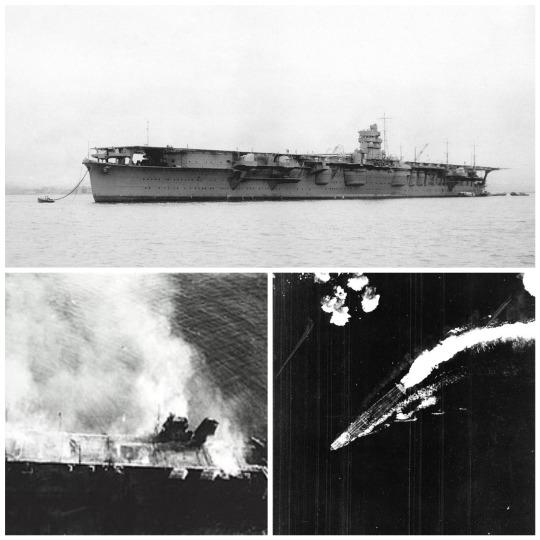
• IJN Aircraft Carrier Hiryū
Hiryū (飛龍, "Flying Dragon") was an aircraft carrier built for the Imperial Japanese Navy (IJN) during the 1930s. Generally regarded as the only ship of her class, she was built to a modified Sōryū design.
Hiryū was one of two large carriers approved for construction under the 1931–32 Supplementary Program. Originally designed as the sister ship of Sōryū, her design was enlarged and modified in light of the Tomozuru and Fourth Fleet Incidents in 1934–1935 that revealed many IJN ships were top-heavy, unstable and structurally weak. Her forecastle was raised and her hull strengthened. Other changes involved increasing her beam, displacement, and armor protection. The ship had a length of 227.4 meters (746 ft 1 in) overall, a beam of 22.3 meters (73 ft 2 in) and a draft of 7.8 meters (25 ft 7 in). She displaced 17,600 metric tons (17,300 long tons) at standard load and 20,570 metric tons (20,250 long tons) at normal load. Her crew consisted of 1,100 officers and enlisted men. Hiryū was fitted with four geared steam turbine sets with a total of 153,000 shaft horsepower (114,000 kW). Hiryū carried 4,500 metric tons (4,400 long tons) of fuel oil which gave her a range of 10,330 nautical miles (19,130 km; 11,890 mi) at 18 knots (33 km/h; 21 mph). The boiler uptakes were trunked to the ship's starboard side amidships and exhausted just below flight deck level through two funnels curved downward.
The carrier's 216.9-meter (711 ft 7 in) flight deck was 27 meters (88 ft 6 in) wide and overhung her superstructure at both ends, supported by pairs of pillars. Hiryū was one of only two carriers ever built whose island was on the port side of the ship (Akagi was the other). It was also positioned further to the rear and encroached on the width of the flight deck, unlike Sōryū. The flight deck was only 12.8 meters (42 ft) above the waterline and the ship's designers kept this figure low by reducing the height of the hangars. The upper hangar was 171.3 by 18.3 meters (562 by 60 ft) and had an approximate height of 4.6 meters (15 ft); the lower was 142.3 by 18.3 meters (467 by 60 ft) and had an approximate height of 4.3 meters (14 ft). Together they had an approximate total area of 5,736 square meters (61,740 sq ft). This caused problems in handling aircraft because the wings of a Nakajima B5N "Kate" torpedo bomber could neither be spread nor folded in the upper hangar. Aircraft were transported between the hangars and the flight deck by three elevators, the forward one abreast the island on the centerline and the other two offset to starboard.
Hiryū's primary anti-aircraft (AA) armament consisted of six twin-gun mounts equipped with 12.7-centimeter Type 89 dual-purpose guns mounted on projecting sponsons, three on either side of the carrier's hull. When firing at surface targets, the guns had a range of 14,700 meters (16,100 yd); they had a maximum ceiling of 9,440 meters (30,970 ft) at their maximum elevation of +90 degrees. Their maximum rate of fire was 14 rounds a minute, but their sustained rate of fire was approximately eight rounds per minute. The ship was equipped with two Type 94 fire-control directors to control the 12.7-centimeter (5.0 in) guns, one for each side of the ship; the starboard-side director was on top of the island and the other director was positioned below flight deck level on the port side. The ship's light AA armament consisted of seven triple and five twin-gun mounts for license-built Hotchkiss 25 mm Type 96 AA guns. Two of the triple mounts were sited on a platform just below the forward end of the flight deck. Hiryū had a waterline belt with a maximum thickness of 150 millimeters (5.9 in) over the magazines that reduced to 90 millimeters (3.5 in) over the machinery spaces and the gas storage tanks. It was backed by an internal anti-splinter bulkhead. The ship's deck was 25 millimeters (0.98 in) thick over the machinery spaces and 55 millimeters (2.2 in) thick over the magazines and gas storage tanks.
Following the Japanese ship-naming conventions for aircraft carriers, Hiryū was named "Flying Dragon". The ship was laid down at the Yokosuka Naval Arsenal on July 8th, 1936, launched on November 16th, 1937 and commissioned on July 5th, 1939. She was assigned to the Second Carrier Division on November 15th. In September 1940, the ship's air group was transferred to Hainan Island to support the Japanese invasion of French Indochina. In February 1941, Hiryū supported the blockade of Southern China. Two months later, the 2nd Carrier Division, commanded by Rear Admiral Tamon Yamaguchi, was assigned to the First Air Fleet, or Kido Butai, on April 10th. Hiryū returned to Japan on August 7th and began a short refit that was completed on September 15th. She became flagship of the Second Division from September 22nd to October 26th while Sōryū was refitting. In November 1941, the IJN's Combined Fleet, commanded by Admiral Isoroku Yamamoto, prepared to participate in Japan's initiation of a formal war with the United States by conducting a preemptive strike against the United States Navy's Pacific Fleet base at Pearl Harbor, Hawaii. On November 22nd, Hiryū, commanded by Captain Tomeo Kaku, and the rest of the Kido Butai, under Vice Admiral Chuichi Nagumo and including six fleet carriers from the First, Second, and Fifth Carrier Divisions, assembled in Hitokappu Bay at Etorofu Island. The fleet departed Etorofu, and followed a course across the north-central Pacific to avoid commercial shipping lanes. Now the flagship of the Second Carrier Division, the ship embarked 21 Mitsubishi A6M Zero fighters, 18 Aichi D3A "Val" dive bombers, and 18 Nakajima B5N "Kate" torpedo bombers. From a position 230 nmi (430 km; 260 mi) north of Oahu, Hiryū and the other five carriers launched two waves of aircraft on the morning of December 7th, 1941 Hawaiian time. In the first wave, 8 B5N torpedo bombers were supposed to attack the aircraft carriers that normally berthed on the northwest side of Ford Island, but none were in Pearl Harbor that day; 4 of the B5N pilots diverted to their secondary target, ships berthed alongside "1010 Pier" where the fleet flagship was usually moored. That ship, the battleship Pennsylvania, was in drydock and its position was occupied by the light cruiser Helena and the minelayer Oglala; all four torpedoes missed. The other four pilots attacked the battleships West Virginia and Oklahoma. The remaining 10 B5Ns were tasked to drop 800-kilogram (1,800 lb) armor-piercing bombs on the battleships berthed on the southeast side of Ford Island ("Battleship Row") and may have scored one or two hits on them, in addition to causing a magazine explosion aboard the battleship Arizona that sank her with heavy loss of life. The second wave consisted of 9 Zeros and 18 D3As, They strafed the airfield, and shot down two Curtiss P-40 fighters attempting to take off when the Zeros arrived and a Boeing B-17 Flying Fortress heavy bomber that had earlier diverted from Hickam Army Airfield, and also destroyed a Stinson O-49 observation aircraft on the ground for the loss of one of their own. The D3As attacked various ships in Pearl Harbor, but it is not possible to identify which aircraft attacked which ship.
While returning to Japan after the attack, Vice Admiral Chūichi Nagumo, commander of the First Air Fleet, ordered that Sōryū and Hiryū be detached on December 16th to attack the defenders of Wake Island who had already defeated the first Japanese attack on the island. The two carriers reached the vicinity of the island on December 21st and launched 29 D3As and 2 B5Ns, escorted by 18 Zeros, to attack ground targets. They encountered no aerial opposition and launched 35 B5Ns and 6 A6M Zeros the following day. The carriers arrived at Kure on 29 December. They were assigned to the Southern Force on January 8th, 1942 and departed four days later for the Dutch East Indies. The ships supported the invasion of the Palau Islands and the Battle of Ambon, attacking Allied positions on the island on January 23rd with 54 aircraft. Four days later the carriers detached 18 Zeros and 9 D3As to operate from land bases in support of Japanese operations in the Battle of Borneo. Hiryū and Sōryū arrived at Palau on January 28th and waited for the arrival of the carriers Kaga and Akagi. All four carriers departed Palau on February 15th and launched air strikes against Darwin, Australia, four days later. Hiryū contributed 18 B5Ns, 18 D3As, and 9 Zeros to the attack. Her aircraft attacked the ships in port and its facilities, sinking or setting on fire three ships and damaging two others. Hiryū and the other carriers arrived at Staring Bay on Celebes Island on February 21st to resupply and rest before departing four days later to support the invasion of Java. On March 1st, 1942, the ship's D3As damaged the destroyer USS Edsall badly enough for her to be caught and sunk by Japanese cruisers. Later that day the dive bombers sank the oil tanker USS Pecos. Two days later, they attacked Christmas Island and Hiryū's aircraft sank the Dutch freighter Poelau Bras before returning to Staring Bay on March 11th to resupply and train for the impending Indian Ocean raid.
On March 26th, the five carriers of the First Air Fleet departed from Staring Bay; they were spotted by a Catalina about 350 nautical miles (650 km; 400 mi) southeast of Ceylon on the morning of April 4th. Six of Hiryū's Zeros were on Combat Air Patrol (CAP) and helped to shoot it down. Hiryū contributed 18 B5Ns and 9 Zeros to the force; the latter encountered a flight of 6 Fairey Swordfish torpedo bombers from 788 Naval Air Squadron en route and shot them all down without loss. The Japanese aircraft encountered defending Hawker Hurricane fighters from Nos. 30 and 258 Squadrons RAF over Ratmalana airfield and Hiryū's fighters claimed to have shot down 11 with 3 Zeros damaged, although the fighters from the other carriers also made claims. On the morning of April 9th, Hiryū's CAP shot down another Catalina attempting to locate the fleet and, later that morning, contributed 18 B5Ns, escorted by 6 Zeros, to the attack on Trincomalee. The fighters engaged 261 Squadron RAF, claiming to have shot down two with two more shared with fighters from the other carriers. On April 19th, while transiting the Bashi Straits between Taiwan and Luzon en route to Japan, Hiryū, Sōryū, and Akagi were sent in pursuit of the American carriers Hornet and Enterprise, which had launched the Doolittle Raid against Tokyo. They found only empty ocean, as the American carriers had immediately departed the area to return to Hawaii. The carriers quickly abandoned the chase and dropped anchor at Hashirajima anchorage on April 22nd. Having been engaged in constant operations for four and a half months, the ship, along with the other three carriers of the First and Second Carrier Divisions, was hurriedly refitted and replenished in preparation for the Combined Fleet's next major operation, scheduled to begin one month hence. While at Hashirajima, Hiryū's air group was based ashore at Tomitaka Airfield, near Saiki, Ōita, and conducted flight and weapons training with the other First Air Fleet carrier units.
Concerned by the US carrier strikes in the Marshall Islands, Lae-Salamaua, and the Doolittle raids, Yamamoto was determined to force the US Navy into a showdown to eliminate the American carrier threat. He decided to invade and occupy Midway Atoll, which he was sure would draw out the American carriers to defend it. The Japanese codenamed the Midway invasion Operation MI. Unknown to the Japanese, the US Navy had divined the Japanese plan by breaking its JN-25 code and had prepared an ambush using its three available carriers, positioned northeast of Midway. On May 25th, 1942, Hiryū set out with the Combined Fleet's carrier striking force in the company of Kaga, Akagi, and Sōryū, which constituted the First and Second Carrier Divisions, for the attack on Midway. Her aircraft complement consisted of 18 Zeros, 18 D3As, and 18 B5Ns. on June 4th, 1942, Hiryū's portion of the 108-plane airstrike was an attack on the facilities on Sand Island with 18 torpedo bombers, one of which aborted with mechanical problems, escorted by nine Zeros. The air group suffered heavily during the attack: two B5Ns were shot down by fighters, with a third falling victim to AA fire. The carrier also contributed 3 Zeros to the total of 11 assigned to the initial CAP over the four carriers. By 07:05, the carrier had 6 fighters with the CAP which helped to defend the Kido Butai from the first US attackers from Midway Island at 07:10. Hiryū reinforced the CAP with launches of 3 more Zeros at 08:25. These fresh Zeros helped defeat the next American air strike from Midway. Although all the American air strikes had thus far caused negligible damage, they kept the Japanese carrier forces off-balance as Nagumo endeavored to prepare a response to news, received at 08:20, of the sighting of American carrier forces to his northeast.
Hiryū began recovering her Midway strike force at around 09:00 and finished shortly by 09:10. The landed aircraft were quickly struck below, while the carriers' crews began preparations to spot aircraft for the strike against the American carrier forces. The preparations were interrupted at 09:18, when the first attacking American carrier aircraft were sighted. Hiryū launched another trio of CAP Zeros at 10:13 after Torpedo Squadron 3 (VT-3) from Yorktown was spotted. Two of her Zeros were shot down by Wildcats escorting VT-3 and another was forced to ditch. While VT-3 was still attacking Hiryū, American dive bombers arrived over the Japanese carriers almost undetected and began their dives. It was at this time, around 10:20, that in the words of Jonathan Parshall and Anthony Tully, the "Japanese air defenses would finally and catastrophically fail." Three American dive bomber squadrons now attacked the three other carriers and set each of them on fire. Hiryū was untouched and proceeded to launch 18 D3As, escorted by six Zeros, at 10:54. Yamaguchi radioed his intention to Nagumo at 16:30 to launch a third strike against the American carriers at dusk (approximately 18:00), but Nagumo ordered the fleet to withdraw to the west. At this point in the battle, Hiryū had only 4 air-worthy dive-bombers and 5 torpedo-planes left. She also retained 19 of her own fighters on board as well as a further 13 Zeros on CAP (a composite force of survivors from the other carriers). At 16:45, Enterprise's dive bombers spotted the Japanese carrier and began to maneuver for good attacking position while reducing altitude. Hiryū was struck by four 1,000-pound (450 kg) bombs, three on the forward flight deck and one on the forward elevator. The explosions started fires among the aircraft on the hangar deck. The forward half of the flight deck collapsed into the hangar while part of the elevator was hurled against the ship's bridge. The fires were severe enough that the remaining American aircraft attacked the other ships escorting Hiryū, albeit without effect, deeming further attacks on the carrier as a waste of time because she was aflame from stem to stern. Beginning at 17:42, two groups of B-17s attempted to attack the Japanese ships without success, although one bomber strafed Hiryū's flight deck, killing several anti-aircraft gunners. Although Hiryū's propulsion was not affected, the fires could not be brought under control. At 21:23, her engines stopped, and at 23:58 a major explosion rocked the ship. The order to abandon ship was given at 03:15, and the survivors were taken off by the destroyers Kazagumo and Makigumo. Yamaguchi and Kaku decided to remain on board as Hiryū was torpedoed at 05:10 by Makigumo as the ship could not be salvaged. Around 07:00, one of Hōshō's Yokosuka B4Y aircraft discovered Hiryū still afloat and not in any visible danger of sinking. The aviators could also see crewmen aboard the carrier, men who had not received word to abandon ship. They finally launched some of the carrier's boats and abandoned ship themselves around 09:00. Thirty-nine men made it into the ship's cutter only moments before Hiryū sank around 09:12, taking the bodies of 389 men with her. The loss of Hiryū and the three other IJN carriers at Midway, comprising two thirds of Japan's total number of fleet carriers and the experienced core of the First Air Fleet, was a strategic defeat for Japan and contributed significantly to Japan's ultimate defeat in the war. In an effort to conceal the defeat, the ship was not immediately removed from the Navy's registry of ships, instead being listed as "unmanned" before finally being struck from the registry on 25 September 1942. The IJN selected a modified version of the Hiryū design for mass production to replace the carriers lost at Midway. Of a planned program of 16 ships of the Unryū class, only 6 were laid down and 3 were commissioned before the end of the war.
#second world war#world war 2#world war ii#wwii#military history#history#long post#naval history#imperial japan#japanese navy#japanese history#aircraft carrier#ships#midway
74 notes
·
View notes
Text
Saturday, March 13, 2021
Lawmakers consider keeping daylight saving time year-round
(Washington Post) After a long, dark winter, our noticeably sunnier evenings are about to turn even brighter. At 2 a.m. Sunday, the clocks will “spring forward” one hour as we return to daylight saving time (DST). The time shift means we lose an hour of sleep, but in exchange we’ll enjoy more evening light for the next eight months — until we “fall back” to standard time again in early November. But what if we advanced the clocks this weekend and never had to turn them back? The idea is gaining some traction after a bipartisan group of U.S. senators this week reintroduced a bill that would eliminate standard time and keep daylight saving time year-round. The Sunshine Protection Act, proposed by Sen. Marco Rubio (R-Fla.), along with four Republican and three Democratic senators, says we should ditch standard time since we only use it four months of the year, from November to March. “The call to end the antiquated practice of clock changing is gaining momentum throughout the nation,” Rubio said in a statement. The United States experimented with year-round DST during the 1970s energy crisis, from January 1974 to October 1975. The dark winter mornings were not too popular, however, and ever since, we’ve switched the clocks back to standard time during the winter months.
With ‘big one’ coming, quake alert system launches in Oregon
(AP) People in Oregon will be better prepared for earthquakes—particularly important in the Pacific Northwest because experts say “the big one” is coming—as an early warning system launched Thursday, the 10th anniversary of a devastating quake and tsunami in Japan. California already has the system, while Washington state will join in May to complete coverage of the West Coast. The ShakeAlert system operated by the U.S. Geological Survey uses seismographic sensors to detect significant earthquakes quickly so alerts reach smartphones and people can seek cover before the shaking starts. “It’s very important that (the three states) are all partners in ShakeAlert, because earthquakes don’t respect geographic boundaries, and we have huge population centers all across the West Coast where earthquake risk is the highest in the contiguous U.S.,” said Gabriel Lotto, ShakeAlert user engagement facilitator for the Pacific Northwest Seismic Network. Earthquakes in the Cascadia subduction zone, which extends from the ocean off Northern California to Canada’s Vancouver Island, have an average magnitude of around 9, making them among the world’s biggest. A quake in that zone has a 37% probability of happening off Oregon in the next 50 years, with a slightly lower chance of one striking near Washington state, according to Chris Goldfinger, an Oregon State University professor and earthquake geologist. When an earthquake is detected, people who have alerts activated on their smartphones will get a message saying, “Earthquake detected! Drop, cover, hold on. Protect yourself.” Mobile apps also carry the alerts.
Rage Spreads in Paraguay as Virus Surges, Exposing Corruption
(NYT) For nearly a year, Paraguay was a leader in keeping the pandemic at bay, and despite its persistent troubles, the country remained fairly calm. Not any more. Paraguay’s coronavirus infection rate has soared, becoming one of the worst in the Americas, and its already shaky health system has been stretched to the breaking point. In the last few days, demonstrators by the thousands have filled streets, demanding the ouster of President Mario Abdo Benítez, and in a few instances there have been bloody clashes with the police. For many Paraguayans, corruption and elite entitlement that were once just unpleasant facts of life have become intolerable in the face of the pandemic. There is a shortage of basic drugs that doctors and nurses blame on graft; nonemergency surgery has been suspended because of a shortfall in medical supplies, and there are few vaccines to be had. The crisis has spilled into the streets with a level of rage the county’s leaders have not faced in years. Daily protests started last Friday with medical workers, who were quickly joined by other frustrated people. Most have been peaceful, but in some cases security forces have met the demonstrators with rubber bullets, tear gas and water cannons. “There are so many deaths and it is all the fault of the thieves who run our corrupt institutions,” said Sergio Duarte, who joined a demonstration outside of Congress on Saturday in Asunción, Paraguay’s capital and largest city.
Amid pandemic, ‘an international epidemic’ of childhood pain
(AP) By the time his parents rushed him to the hospital, 11-year-old Pablo was barely eating and had stopped drinking entirely. Weakened by months of self-privation, his heart had slowed to a crawl and his kidneys were faltering. Medics injected him with fluids and fed him through a tube—first steps toward stitching together yet another child coming apart amid the tumult of the coronavirus crisis. For doctors who treat them, the pandemic’s impact on the mental health of children is increasingly alarming. The Paris pediatric hospital caring for Pablo has seen a doubling in the number of children and young teenagers requiring treatment after attempted suicides since September. Doctors elsewhere report similar surges, with children—some as young as 8—deliberately running into traffic, overdosing on pills and otherwise self-harming. In Japan, child and adolescent suicides hit record levels in 2020, according to the Education Ministry. Pediatric psychiatrists say they’re also seeing children with coronavirus-related phobias, tics and eating disorders, obsessing about infection, scrubbing their hands raw, covering their bodies with disinfectant gel and terrified of getting sick from food. Also increasingly common, doctors say, are children suffering panic attacks, heart palpitations and other symptoms of mental anguish, as well as chronic addictions to mobile devices and computer screens that have become their sitters, teachers and entertainers during lockdowns, curfews and school closures. “There is no prototype for the child experiencing difficulties,” said Dr. Richard Delorme, who heads the psychiatric unit treating Pablo at the giant Robert Debré pediatric hospital, the busiest in France. “This concerns all of us.”
Everest reopens
(NYT) Nepal has reopened to foreign tourists who test negative for the coronavirus and spend one week in quarantine, meaning an often-overcrowded Everest has reopened to climbers. The decision to reopen the peak is proving controversial, with at least one tour company canceling its spring expeditions over safety concerns. Meanwhile, some in Nepal want to see restrictions eased even further, as many of the cooks and porters who typically make a living as support staff for Everest climbs have struggled to feed their families amid the sudden loss of income.
Myanmar junta kills more protesters, adds Suu Kyi accusation
(AP) Myanmar’s security forces shot to death at least 10 people protesting the military’s coup Thursday, spurning a U.N. Security Council appeal to stop using lethal force and as an independent U.N. expert cited growing evidence of crimes against humanity. The military also lodged a new allegation against the deposed government leader Aung San Suu Kyi, alleging that in 2017-18 she was illegally given $600,000 and gold bars worth slightly less by a political ally. She and President Win Myint have been detained on less serious allegations and the new accusation was clearly aimed at discrediting Suu Kyi and perhaps charging her with a serious crime.
China legislature endorses reducing public vote in Hong Kong
(AP) China’s ceremonial legislature on Thursday endorsed the ruling Communist Party’s move to tighten control over Hong Kong by reducing the role of its public in picking the territory’s leaders. The measure drew condemnation from Britain and the U.S. and accusations it will disenfranchise Hong Kong’s people. It adds to a crackdown against a protest movement in Hong Kong calling for greater democracy. The crackdown has prompted accusations Beijing is eroding the autonomy it promised when the former British colony was returned to China in 1997 and is hurting its status as a global financial center. Beijing’s crackdown on Hong Kong has added to irritants in China’s relations with Washington, Europe and other governments that also include trade, technology and the party’s treatment of ethnic minorities.
Japan to tighten border control against variants
(AP) Transportation minister Kazuyoshi Akaba says Japan will tighten border controls and limit the number of entrants to up to 2,000 per day to guard against the more contagious variants of the coronavirus. The health authorities have found the cases of the new variants to have quadrupled over the past month. They said the cases have been found in about half of Japan’s 47 prefectures but need to be closely watched and precautions should be increased. Tokyo and its three neighboring prefectures are under a non-binding state of emergency since Jan. 7. The measure, which was to end on March 7 in those areas, has been extended for two weeks as the infections have not slowed enough.
‘People are starving’: New exodus in Ethiopia’s Tigray area
(AP) Skinny, hungry, fleeing threats of violence, thousands of people who have been hiding in rural areas of Ethiopia’s Tigray region have begun arriving in a community that can barely support them—and more are said to be on the way. For months, one great unknown in the Tigray conflict has been the fate of hundreds of thousands of people in vast rural areas beyond the reach of outside aid. With the region largely cut off from the world since November, fears of violence and starvation have grown. Now those people are starting to arrive, many by foot, in the community of Shire, aid workers who are there and who have visited say. Some 5,000 people had arrived between last Wednesday and Sunday, and humanitarian teams are being sent to find those said to be on the way, Oliver Behn, general director for Doctors Without Borders-Holland, told the AP. “They are coming in very bad conditions … very exhausted, dehydrated, skinny,” Behn said after a visit. “It’s becoming a desperate situation very quickly.” The people arriving bring an idea of the deprivation gnawing at the Tigray countryside. Aid workers say some describe surviving by eating leaves—or the seeds they had put aside for planting, in a sign of even worse hunger to come.
4 notes
·
View notes